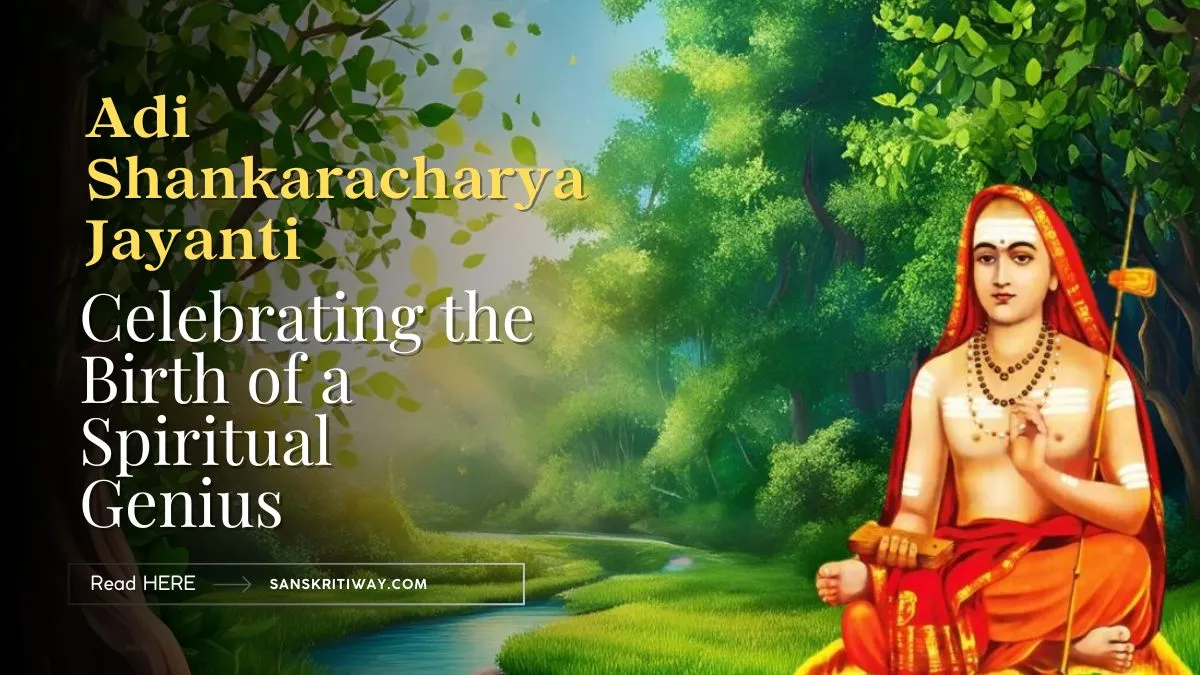Adi Shankaracharya Jayanti is a commemoration of the life of Jagadguru Adi Shankaracharya, as he is regarded as the finest India has seen in terms of spiritual philosophers and reformers. He established Advaita Vedanta and pioneered its non-duality (Advaita) clause, which indicates that Atman (self) and Brahman (the Supreme Reality) are indeed one. Shankaracharya influences Hindu philosophy to this day by providing teachings that enable people to realize and liberate (moksha) themselves.
In Vaishakha (April-May), people celebrate this auspicious day on the Panchami Tithi (fifth day) of Shukla Paksha. This year, Adi Shankaracharya Jayanti is on May 2, a Friday in 2025.
Historical Significance
Shankaracharya was born in 788 AD in Kalady, Kerala. Even though he spent only 32 years on this planet, his philosophical and spiritual influence on Hindus is profound. Shankaracharya roamed around India debating with scholars while recognizing the value of Vedic traditions and setting up monastic establishments (mathas). His main objective was to have Sanatana Dharma, which had become lost in superstitions and rituals, mainstreamed again.
Important Achievements of Adi Shankaracharya
- Advaita Vedanta: He not only promoted the notion but also the crucial point of emphasizing Atman (soul) and Brahman (Supreme) being one and unified and considering the illusion of duality abolished.
- Philosophical Texts: Commentaries on the Upanishads, the Bhagavad Gita, and Brahmasutras remain essential in Hindu philosophy.
- Monastic System: Founded 4 mathas—in Sringeri, Dwarka, Puri and Badrinath—thus preserving the knowledge of the Vedas.
- Devotional literature: Nirvana Shatakam, Bhaja Govindam, and Soundarya Lahari are some of the Sanskrit hymns he authored that are still chanted today.
- Hindu Unity: Attempted to bring together various sects and forms of worship into a single Vedic order.

The Four Disciples of Adi Shankaracharya
‘Adi’ Shankaracharya divided the kingdom of Brahma into four regions. He designated each part with a head and named them dwelled mats, or mathas. He then appointed four principal disciples devoted to the teachings of Advaita Vedanta.
Padmapadacharya (Govardhan Math, Puri—East India)
- He is best known for his devotion to Shankracharya.
- He was instrumental in propagating Advaita Vedanta.
- Wrote “Panchapadika” commentary on Shankara’s Brahmasutra Bhashya.
Hastamalakacharya (Dwaraka Math, Gujarat—West India)
- He was a child genius who instantly appreciated the philosophy of non-duality.
- His treatise “Hastamalakiyam” explains non-duality in a sophisticated yet simple manner.
Totakacharya (Jyotir Math, Uttarakhand—North India)
- Slow learner at the beginning but received Shankara’s grace, which helped him obtain spiritual wisdom.
- He became a devotee after writing Totakashtakam, a hymn to his guru.
Sureshwaracharya (Sringeri Math, Karnataka—South India)
- He was originally known as Mandana Mishra, a staunch opponent of Advaita who later became Shankaracharya’s disciple.
- Vartika (commentary) on Shankara’s works and other explanations of Vedanta were added.
These disciples ensured that the teachings of Advaita Vedanta were kept alive, along with the teachings of Shankaracharya.
Legends Associated with Adi Shankaracharya
1. The Crocodile Incident—Choosing Monkhood
As a child, Shankara wanted to renounce (sannyasa) everything. His mother never sat down to reason with him, but after some time she agreed. One day while he was bathing in a river, a crocodile bit his leg. If his mother would allow him to become a monk, he told her, then the crocodile would set him free. Somehow, she did agree. Bizarrely, the crocodile let him go. This act marks the beginning of his spiritual journey.
2. The Debate with Mandana Mishra
He engaged in one of the most famous debates with Mandana Mishra, a formidable opponent. He, along with his wife Ubhaya Bharati, was a scholar of outstanding repute. Shankara won the debate, and Mandana Mishra became a monk and one of Shankara’s best disciples (Sureshwaracharya).
3. Encounter with a Chandala (Untouchable)
The other day, Shankara Charya encountered a Chandala (untouchable class) and told him to move. The response of the Chandala was, “Who are you ordering to move? The body or the soul? If everything is Brahman, what does it entail?” This answer rounded Shankaracharya’s circle of understanding Advaita, deepening his appreciation for his goal of abolishing discrimination.
Celebrations & Rituals of Adi Shankaracharya Jayanti
India celebrates Adi Shankaracharya Jayanti with great joy, particularly in temples and monastic institutions honoring his legacy.
How is the Jayanti celebrated?
- People perform Puja and Homa in temples to worship Shankaracharya and deepen their appreciation for him.
- Singing the Bhagavad Gita and Upanishads, in addition to his philosophical writings devoted to him, are remembered too.
- Discourses on Advaita Vedanta and Shankara’s philosophies.
- Charitable acts in the form of food donation and Anna Daan’s food donation in his reverence are being highlighted.
- Nirvana Shatakam and Govindam hymns are worshipped through singing that praises him.
Teachings of Adi Shankaracharya
Adi Shankaracharya’s philosophy remains relevant in modern times, offering a path to inner peace and spiritual awakening. Some of his key teachings include:
- “ Aham Brahmasmi” (I am Brahman) that states: You fact, are not just your body or mind, but the supreme cognizance itself.
- “Brahma Satyam, Jagat Mithya” (Brahman is real, the world is an illusion): Although the world around us constantly changes, the innermost self of a human being remains unchanged and eternal.
- Let go of the material world: A person is truly peaceful when they have achieved self-contentment, regardless of their status in society.
- Serve mankind with knowledge and love: Compassionate actions towards others set one on one’s journey towards spiritual upliftment.
The life of Adi Shankaracharya epitomized spiritual unification and rejuvenation; his wisdom guided many people all around the world. As we celebrate and observe Adi Shankaracharya Jayanti, it compels us to reflect upon the life and lessons of Shankaracharya and appreciate the dedication of a wise man achieving strength through self-exploration and humble service to people.
Let Shankaracharya Jayanti inspire the world in the path of self-realization guided by the wisdom of Shankaracharya.
Visit Sanskriti Way



